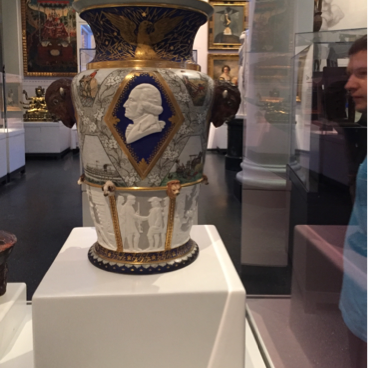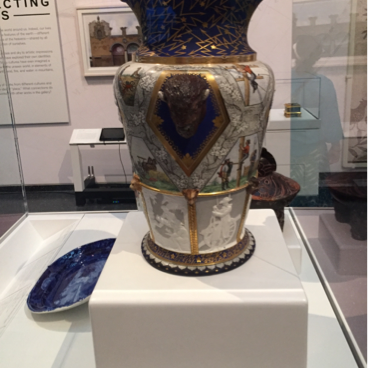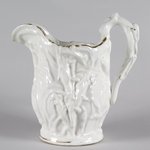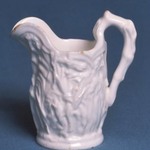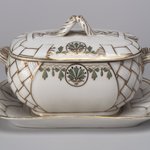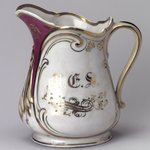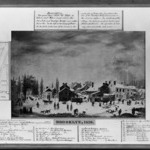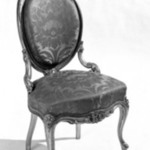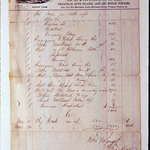

Karl L. H. Müller (American, born Germany, 1820–1887). Century Vase, 1876. Porcelain, Height: 22 1/4 in. (56.5 cm). Brooklyn Museum, Gift of Carll and Franklin Chace, in memory of their mother, Pastora Forest Smith Chace, daughter of Thomas Carll Smith, the founder of the Union Porcelain Works, 43.25. Creative Commons-BY (Photo: Brooklyn Museum, 43.25_SL1.jpg)

Karl L. H. Müller (American, born Germany, 1820–1887). Century Vase, 1876. Porcelain, Height: 22 1/4 in. (56.5 cm). Brooklyn Museum, Gift of Carll and Franklin Chace, in memory of their mother, Pastora Forest Smith Chace, daughter of Thomas Carll Smith, the founder of the Union Porcelain Works, 43.25. Creative Commons-BY (Photo: Brooklyn Museum, 43.25_back_PS1.jpg)

Karl L. H. Müller (American, born Germany, 1820–1887). Century Vase, 1876. Porcelain, Height: 22 1/4 in. (56.5 cm). Brooklyn Museum, Gift of Carll and Franklin Chace, in memory of their mother, Pastora Forest Smith Chace, daughter of Thomas Carll Smith, the founder of the Union Porcelain Works, 43.25. Creative Commons-BY (Photo: Brooklyn Museum, 43.25_bison_PS1.jpg)

Karl L. H. Müller (American, born Germany, 1820–1887). Century Vase, 1876. Porcelain, Height: 22 1/4 in. (56.5 cm). Brooklyn Museum, Gift of Carll and Franklin Chace, in memory of their mother, Pastora Forest Smith Chace, daughter of Thomas Carll Smith, the founder of the Union Porcelain Works, 43.25. Creative Commons-BY (Photo: Brooklyn Museum, 43.25_Boston_Tea_Party_PS1.jpg)

Karl L. H. Müller (American, born Germany, 1820–1887). Century Vase, 1876. Porcelain, Height: 22 1/4 in. (56.5 cm). Brooklyn Museum, Gift of Carll and Franklin Chace, in memory of their mother, Pastora Forest Smith Chace, daughter of Thomas Carll Smith, the founder of the Union Porcelain Works, 43.25. Creative Commons-BY (Photo: Brooklyn Museum, 43.25_francis_marion_PS1.jpg)

Karl L. H. Müller (American, born Germany, 1820–1887). Century Vase, 1876. Porcelain, Height: 22 1/4 in. (56.5 cm). Brooklyn Museum, Gift of Carll and Franklin Chace, in memory of their mother, Pastora Forest Smith Chace, daughter of Thomas Carll Smith, the founder of the Union Porcelain Works, 43.25. Creative Commons-BY (Photo: Brooklyn Museum, 43.25_native_american_chief_PS1.jpg)

Karl L. H. Müller (American, born Germany, 1820–1887). Century Vase, 1876. Porcelain, Height: 22 1/4 in. (56.5 cm). Brooklyn Museum, Gift of Carll and Franklin Chace, in memory of their mother, Pastora Forest Smith Chace, daughter of Thomas Carll Smith, the founder of the Union Porcelain Works, 43.25. Creative Commons-BY (Photo: Brooklyn Museum, 43.25_settler_PS1.jpg)

Karl L. H. Müller (American, born Germany, 1820–1887). Century Vase, 1876. Porcelain, Height: 22 1/4 in. (56.5 cm). Brooklyn Museum, Gift of Carll and Franklin Chace, in memory of their mother, Pastora Forest Smith Chace, daughter of Thomas Carll Smith, the founder of the Union Porcelain Works, 43.25. Creative Commons-BY (Photo: Brooklyn Museum, 43.25_soldier_PS1.jpg)
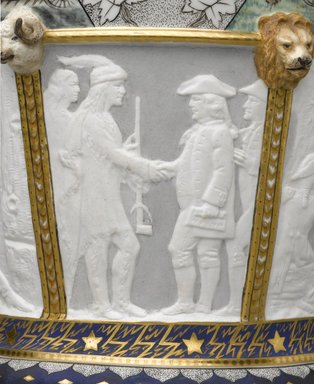
Karl L. H. Müller (American, born Germany, 1820–1887). Century Vase, 1876. Porcelain, Height: 22 1/4 in. (56.5 cm). Brooklyn Museum, Gift of Carll and Franklin Chace, in memory of their mother, Pastora Forest Smith Chace, daughter of Thomas Carll Smith, the founder of the Union Porcelain Works, 43.25. Creative Commons-BY (Photo: Brooklyn Museum, 43.25_william_penn_PS1.jpg)
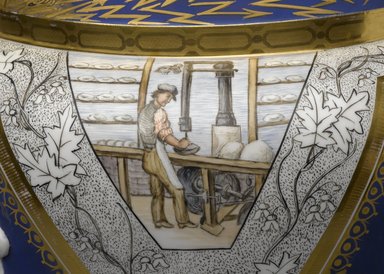
Karl L. H. Müller (American, born Germany, 1820–1887). Century Vase, 1876. Porcelain, Height: 22 1/4 in. (56.5 cm). Brooklyn Museum, Gift of Carll and Franklin Chace, in memory of their mother, Pastora Forest Smith Chace, daughter of Thomas Carll Smith, the founder of the Union Porcelain Works, 43.25. Creative Commons-BY (Photo: Brooklyn Museum, 43.25_factory_PS1.jpg)
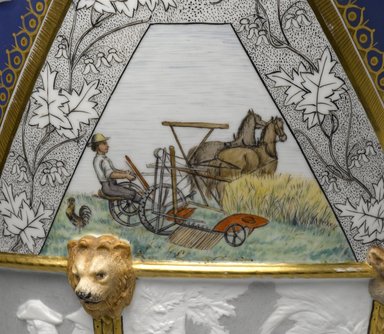
Karl L. H. Müller (American, born Germany, 1820–1887). Century Vase, 1876. Porcelain, Height: 22 1/4 in. (56.5 cm). Brooklyn Museum, Gift of Carll and Franklin Chace, in memory of their mother, Pastora Forest Smith Chace, daughter of Thomas Carll Smith, the founder of the Union Porcelain Works, 43.25. Creative Commons-BY (Photo: Brooklyn Museum, 43.25_farmer_reaper_PS1.jpg)

Karl L. H. Müller (American, born Germany, 1820–1887). Century Vase, 1876. Porcelain, Height: 22 1/4 in. (56.5 cm). Brooklyn Museum, Gift of Carll and Franklin Chace, in memory of their mother, Pastora Forest Smith Chace, daughter of Thomas Carll Smith, the founder of the Union Porcelain Works, 43.25. Creative Commons-BY (Photo: Brooklyn Museum, 43.25_loading_from_boat_PS1.jpg)

Karl L. H. Müller (American, born Germany, 1820–1887). Century Vase, 1876. Porcelain, Height: 22 1/4 in. (56.5 cm). Brooklyn Museum, Gift of Carll and Franklin Chace, in memory of their mother, Pastora Forest Smith Chace, daughter of Thomas Carll Smith, the founder of the Union Porcelain Works, 43.25. Creative Commons-BY (Photo: Brooklyn Museum, 43.25_plow_PS1.jpg)

Karl L. H. Müller (American, born Germany, 1820–1887). Century Vase, 1876. Porcelain, Height: 22 1/4 in. (56.5 cm). Brooklyn Museum, Gift of Carll and Franklin Chace, in memory of their mother, Pastora Forest Smith Chace, daughter of Thomas Carll Smith, the founder of the Union Porcelain Works, 43.25. Creative Commons-BY (Photo: Brooklyn Museum, 43.25_steamship_PS1.jpg)

Karl L. H. Müller (American, born Germany, 1820–1887). Century Vase, 1876. Porcelain, Height: 22 1/4 in. (56.5 cm). Brooklyn Museum, Gift of Carll and Franklin Chace, in memory of their mother, Pastora Forest Smith Chace, daughter of Thomas Carll Smith, the founder of the Union Porcelain Works, 43.25. Creative Commons-BY (Photo: Brooklyn Museum, 43.25_telegraph_PS1.jpg)

Karl L. H. Müller (American, born Germany, 1820–1887). Century Vase, 1876. Porcelain, Height: 22 1/4 in. (56.5 cm). Brooklyn Museum, Gift of Carll and Franklin Chace, in memory of their mother, Pastora Forest Smith Chace, daughter of Thomas Carll Smith, the founder of the Union Porcelain Works, 43.25. Creative Commons-BY (Photo: Brooklyn Museum, 43.25_telegraph2_PS1.jpg)

Karl L. H. Müller (American, born Germany, 1820–1887). Century Vase, 1876. Porcelain, Height: 22 1/4 in. (56.5 cm). Brooklyn Museum, Gift of Carll and Franklin Chace, in memory of their mother, Pastora Forest Smith Chace, daughter of Thomas Carll Smith, the founder of the Union Porcelain Works, 43.25. Creative Commons-BY (Photo: Brooklyn Museum, 43.25_woman_sewing_PS1.jpg)

Karl L. H. Müller (American, born Germany, 1820–1887). Century Vase, 1876. Porcelain, Height: 22 1/4 in. (56.5 cm). Brooklyn Museum, Gift of Carll and Franklin Chace, in memory of their mother, Pastora Forest Smith Chace, daughter of Thomas Carll Smith, the founder of the Union Porcelain Works, 43.25. Creative Commons-BY (Photo: Brooklyn Museum, 43.25_washington_PS1.jpg)
Century Vase
Decorative Arts and Design
On View: Decorative Art, 20th-Century Decorative Arts, 4th Floor






